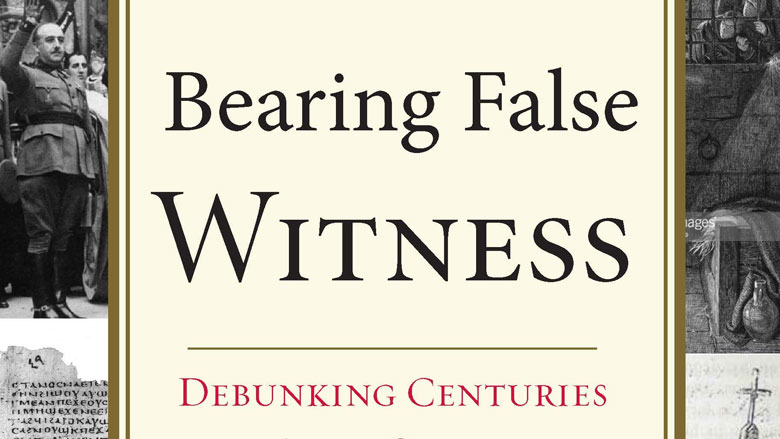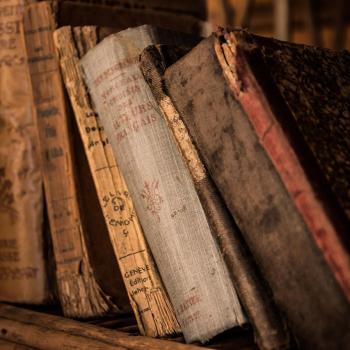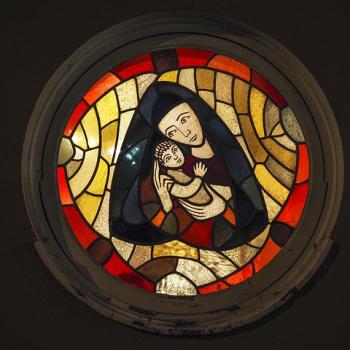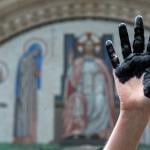
(This review is a contribution to the June edition of the Patheos Book Club.)
When I first started reading Rodney Stark’s new book, Bearing False Witness: De-bunking Centuries of Anti-Catholic History I expected I would end up writing a fairly positive review with some mild criticisms and a few statements about what this sort of anti-expose can and can’t accomplish. I was pleasantly surprised when I found myself not merely appreciating, but positively enjoying the first few chapters. It was less pleasant that instead of finding minor criticisms to offer as the book progressed I found Stark’s claims increasing less reliable towards the end of the book. On the whole I will have to offer stronger criticism than I had in mind; however, it is a book that, flaws and all, is worth your time. Stark provides a valuable resource for general audiences that is also a useful addition to the bookshelf of anyone working in history, Christian theology, religious studies and related fields. Undergraduates in these fields should make sure to read it.
Stark argues that many pieces of popular wisdom about the history (and especially the historical evil) of the Catholic Church are in fact unfounded inventions. However, these falsifications find a credulous audience and ardent repetition from those who have already formed a negative judgment of the Church. He is especially wary of judgments pronounced against the Catholic Church by ex-members of the Church, and by others who make their allegedly historical claims against a background of anti-catholic bias. In setting this for his point of departure, Stark does not aim to offer a defense of the Catholic Church, but rather a defense of historical honesty. Stark deems all claims made by opponents of the Catholic faith suspect of special pleading. He sees himself an impartial witness because, as a Lutheran, he is outside the Catholic Church. This is perhaps a little overstated – an anti-catholic claim could be dismissed for lack of evidence without its being motivated by malice or prejudice. Also, while Stark is not a member of what is today the Catholic Church, many of his defenses of history deal with history prior to Martin Luther – history that his own Church community shares with contemporary Catholicism. An historical claim need need not be made by a witness impartial to blame, sympathy and other judgments, but it does need more evidence when that bias is heavy – additional witness who can confirm or deny. Knowing this, Stark deals not with mere lack of evidence and refutation, but also seeks positive evidence for a quite different narrative than that offered by pop anti-Catholicism. In this respect, Stark’s text shines, and the reader who wishes to verify, modify or even challenge him on specifics will find extensive resources in Stark’s notations and bibliography.
His opening chapter on anti-semitism sets the tone. There is no quest to establish a plea of innocence for the Church or Christians but a goal of clearing the ground of outrageous negative claims. Although the treatment of the historical failures of the Church to more thoroughly and effectively condemn anti-semitism as such is lacking, Stark capably presents the well-documented, constant and unequivocal Catholic condemnation of anti-semitic violence. He also implicitly establishes an important historical standard that, while never stated in as many words, is implicit here and foundational to his argument throughout the book. Whatever one might wish to say about the Church’s responsibility for her members and historical moments of de facto tolerance of crimes and sins officially condemned, to indite the Church as an institution and its teaching per se, the alleged wrongdoing must be established from official teaching, official rulings and the authoritative judgments issued at an institutional level. I dearly wish Stark had more to say (ahem – anything to say) on the former. Nonetheless in his intended task of establishing the historical innocence of the later he does well.
His chapter on Gnostic writings expertly vivisects the popular claim that any Christian community ever revered these texts as equivalent to the the four received gospels (in case anyone still had doubts). The interested reader should look elsewhere for a treatment of their intrinsic historical significance- as artifacts of communities that mixed Christian and pagan elements freely and as the losing contenders for the theological identity of Christianity in a pagan religious world.
The chapters on Christian persecution of pagans and the notion of the “Dark Ages” both make strong cases. There wasn’t much persecution, and paganism seems to have continued in quiet even centuries after it fades from records. The concept of the “Dark Ages” is a retrospective creation of scholars who ignored the technological, economic and cultural developments of the centuries placed under the label- many of which were positive achievements whose value was simply taken for granted. Whatever may be traced of the reception of classical learning and culture in later European history, it is a history of Christian scholars and cultures, not one of Christian suppression and secular recovery. The notion of “Dark Ages” deserves the dust bin specialists have left it in for many decades.
If you thought the crusades were started for conquest, constitute the beginning of European colonialism or were waged for material gain, you have some reading to do; you have been misinformed. Crusader armies were a brutal and unpleasant lot, much like the Muslim armies they fought against and held to similar, sometimes permissive, standards when it came to what are rightly called war crimes today. I wish some mention were made here (as in Stark’s earlier book on the crusades) of the sad legacy of the Crusades in the history of division and violence between Western and Eastern Christians. As for today’s ubiquitous claims about the legacy of the crusades in violence and hatred between Christians and Muslims- such claims can’t be found in Christian or Muslim sources before about 1900. 20th and 21st century politics heavily color such historical claims.
The chapter on the Spanish Inquisition is a must-read for those who know it by reputation, but have not studied it well. The number of its cases and the severity of the punishments inflicted are vastly lower than commonly reported. By the standards of the secular courts of its day, it was even rather lenient. (Let me add what Stark doesn’t- such a comparison leaves a lot of room for indicting European legal standards of the era.) And while witch burning did spread through Europe in that era, under the Spanish Inquisition the practice was suppressed. If you have heard of the Inquisition burning books, you might be surprised to learn that most of the books it burned where targeted not for their teaching, but for being among the earliest printed pornography.
Chapter 7, “Scientific Heresies,” will hold no surprises for anyone who has read any recent history of early modern science. In sum – our modern era owes much to ecclesiastically encouraged and ecclesiastically approved research, most of which was done by Christians of sincere religious conviction. And Galileo might have gotten into less trouble (and fewer ecclesiastical courts) if he had followed the convention of his day and stated clearly that his scientific theories held no theological significance. (But don’t expect a comprehensive account of Galileo or Galileo scholarship in less than one chapter.) Crucial to Stark’s vision of Christian history, and most prominent in this chapter, is the claim that Christian cosmology was the wellspring of modern science, especially because of its confidence in a rationally decipherable universe. This case seems overstated here and throughout the book- Stark does not seem to have a sense that this is an area where Christianity and classical thought (Neo-Platonism in particular) converge. But it would be hard to not grant Stark the weaker claim that scientific progress, like technological, intellectual and economic development, have always been not only encouraged but actively supported by the Church.
The chapter on slavery is the weirdest and weakest in Bearing False Witness. Here Stark relies more heavily than anywhere else on a defense of official Christian teaching which, as Stark well documents, has never had any real acceptance of slavery – having subverted and eventually abolished the ancient institution and early and repeatedly condemned modern versions. But nowhere does Stark really confront the evil of Christian nations and allegedly Christian persons creating, perpetuating and defending the African slave trade. While he makes many a defensible individual claim along the way he mostly misses the viewpoint and and purpose of the accusations he aims to counter. Certainly, the Catholic Church, as a corporate institution centered in Rome, preserved and reiterated the Christian teaching against slavery developed in the 4th- 7th centuries, and deployed it first against the enslavement of American Native Peoples and later against the even more horrific Atlantic slave trade. This alone fails to tell the story of the troubled history of Christianity and slavery, and cannot eliminate any need for apology, much less the need for penance and self-questioning, that should be the Christian response to this troubled history.
Stark’s chapter on “Holy Authoritarianism” – mostly on the history of the relationship of the Catholic Church to both authoritarian and liberal democratic government respectively- is flawed in its simultaneous attempt to accomplish too little and too much. To trace the violent rejection of Catholicism and religion per se contained among the excesses of the French revolution without also attempting to assess the prior relationship of the Church in France to the unjust economic and social conditions of pre-revolutionary France, is too little. To speak of the Church’s defensive reaction to the French revolution and to more recent authoritarian regimes, and not speak of the occasional excesses of that reaction, is too much. Divine right of kings did indeed originate as a Protestant theory in the 17th century, but it did have attractive power and an unfortunate influence on many Catholic thinkers in the 19th and early 20th centuries. A sometimes disturbing fondness for monarchy and a taste for authoritarianism in spirituality is part of this period’s Catholic intellectual history, a part that Stark seems unaware of. But this does not weaken the account Stark does offer of those elements of the Church’s history that do draw his eye.
This is also one of the places Stark waxes interpretive to a greater degree. To better illuminate recent history of the Church with secular government, he makes use of the theory of two Churches existing within the history of the Catholic Church- one of piety, rooted in faith; and one of power, content with building, maintaining and benefiting from earthly power. But this history doesn’t map as easily as he might wish into his discussion of specifically modern government (1800-present). His application of this heuristic to the Christianity of 300-1000 AD is simply confusing and offers too little evidence. He rightly sees the papacy of St. Gregory VII (1073- 1085) as a major triumph of spiritual motives and piety over worldly desire in the Church But he does not apply the theory at all to the many reform movements of the 12th – 15th centuries, confidently leaping over them to tell of the final victory of the “Church of Piety” via the combined influence of the Protestant Reformation and the Tridentine reform of the Roman Church. Some of the movements he omits earned ecclesiastical sanction, such as the Cathars and Waldensians, but others quickly become venerated parts of the Church- among them, the Dominican and Franciscan orders. In an account of the struggle between spiritual and worldly power in Church history, the Avignon papacy deserved at least a mention, but it finds none here. This theory is one I am interested to study more, but Stark’s use of it smacks heavily of special pleading for a specifically Protestant and distinctly theological interpretation of history.
His chapter on economic history and the Church is simply a morass. I will leave it to those more qualified in historical and theoretical economics to tease out just what can be salvaged and what discarded here. I will content myself with suggesting that the reader who desires to understand the Church’s view of economies and markets consult recent social encyclicals instead of Rodney Stark.
While this would have been a more positive review if it had been a review of the first three quarters of the book, my criticisms should not mislead the reader to sell Bearing False Witness short. Thankfully, no apology for the Catholic Church and no triumphalism can be found in it; rather, it provides a sweeping ground-clearing of many unreasonable and often unscholarly claims that are frequently treated as received wisdom when speaking about the Catholic Church. It neither offers, nor claims to offer, a final word on the many subjects it treats. Even its worst passages offer an interesting word, an accessible text and an abundance of references. It is an excellent tool for forming a better popular view of the Church’s varied role in Western history. It is also a help to those interested in providing either an internal or an external critique of the Church’s historical faults (faults which have occurred at official and unofficial levels). The work of cutting away false accusations makes room for valid critiques. Let the reader enjoy.













